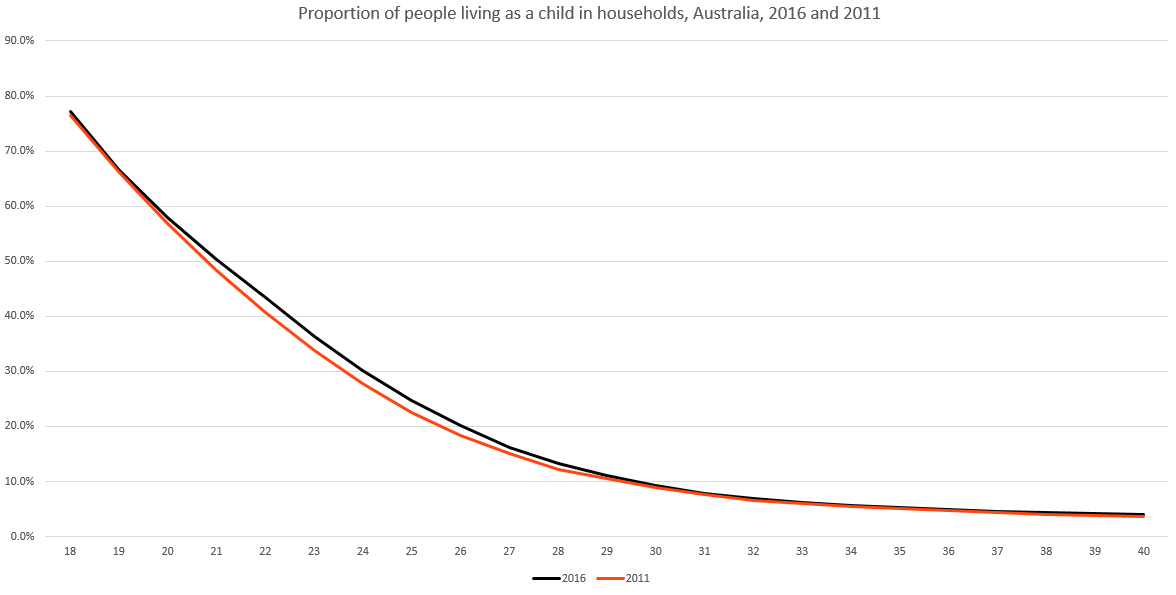Are children staying at home for longer?
There has been a lot of talk about housing affordability in recent years, particularly housing affordability for young people.
There is no doubt that housing is extremely expensive to own or rent in our capital cities now. However, the 2016 Census showed that mortgage repayments actually decreased slightly, due to lower interest rates.
Despite this, many commentators are saying that young people can’t afford to move out of home. Some are even going as far as to blame the Smashed Avocado breakfast for using up too much of our income.
But what does the 2016 Census data show?
How many young people are still living at home with their parents, and how many have made the shift out? At what age do they do it, and how is that changing?
This chart shows the proportion of people in each single year of age from 18 to 40 years old, who are living in a household, with a relationship in that household being “Non-dependent child”. In other words, they are still living at home with one or more parents.

Source: 2016 Census of Population and Housing, Enumerated data, from ABS Tablebuilder
At 18 years of age, 74% are still living at home with their parents. By age 40, this has dropped to 4%.
There are still some in this category right through to over 60s, but it’s likely for these older ones that the care relationship is reversed, and they are looking after elderly parents.
What we can see is that the during the 20-something age range, 4-6% move out with each additional year (from 51% at age 20 to just 9% still living at home at age 30).
This is changing, but only slightly.
In the 2011 Census, 41.4% of 20-24 year-olds were still living with parents. By 2016, this had risen 2% to 43.4%.
The equivalent figures for 25-29 year-olds rose from 15.7% to 17.0%. We also looked at the 2006 figures, but there was virtually no change from 2006 to 2011.
So these increases are not enormous, and hardly show an emerging epidemic of children staying at home.
24 year-olds sticking around
In 2016, 70% of 24-year-olds had left the family home to live independently.
However, this is also the age bracket where we saw the biggest change between 2011 and 2016, with a 3% differential.
In summary, We could say that changes in demographics and housing trends have led to the average child delaying leaving home by approximately 6 months over the past 5 years.
Country kids getting out earlier
It’s really interesting to look at differences between Metropolitan Australia (represented by the 8 capital cities) and Regional Australia (everywhere else).
We know that many regional areas struggle to retain their young people, who move to metropolitan areas for the bright lights of the city, and access to education and employment opportunities.
The chart below shows that those who do stay in regional Australia are more likely to be living independently than their counterparts in the cities.

The difference between Metropolitan and Regional Australia is quite clear in this chart. Between the ages of 18 and 32, young people living outside capital cities are consistently less likely to be living with parents and more likely to be living independently.
Above the age of 32 the difference diminishes. The largest difference is in the 20-24 age range, where 46% of Metropolitan youth were still living at home with parents, and 36% of Regional youth. This is despite the fact that many regional youths move to metropolitan areas to live independently.
The cost:benefit of city living
Why are we seeing this trend? The answer is likely to be to be at least partly to do with cost of living. Housing costs in particular are more expensive in metropolitan areas, so if youths want to remain in the city they grew up in, they are choosing to stay with the family longer than their regional cousins.
These metropolitan kids are also likely to have more access to education and employment while staying at home, so they are less likely to leave, whereas youth in regional areas, even if they stay within regional areas, are more likely to have to move to another area to access these things.
So yes – children are living at home for longer. But only a bit longer, and mainly in metropolitan areas.
So what happens when they leave home?
When they do leave home, are young people buying houses, or renting?
This table shows the results for Metropolitan and Regional Austraila for the past 2 Censuses.
| Total 20-29 year olds living independently | ||||||
| 2016 | 2011 | |||||
| Metropolitan | Regional | Australia | Metropolitan | Regional | Australia | |
| Owned outright | 6.0% | 5.2% | 5.8% | 6.0% | 5.1% | 5.7% |
| Owned with a mortgage | 26.4% | 30.0% | 27.4% | 30.0% | 32.7% | 30.8% |
| Rented | 62.8% | 59.1% | 61.8% | 59.9% | 56.6% | 58.9% |
More renters
So in 2016, 61.8% of 20-29-year-olds who were living away from their parents were renting. The proportion is slightly higher in Metropolitan than regional areas, but broadly similar. The interesting point is the change, with the proportion of 20-somethings renting rising 3% from 58.9% in 2011. The increase is even a little higher for metropolitan areas.
There has also been a sharp drop in those with a mortgage. While the trend is present across-the-board, it’s particularly evident in metropolitan areas, where it has fallen from 30% to 26.4% (a 3.6% drop). The equivalent drop in regional areas is 2.7%
So children are leaving home a bit later, but the change hasn’t been marked. However, when they do leave home, there has been a significant decrease in those buying houses with a mortgage, and a significant increase in renting.
This does point to an issue with housing affordability, however, it should be noted that this age group has always had a high rate of renting – they are young and often need to be mobile.
Would you like a future blog to look more closely at the level of renting across all age groups? Let us know in the comments!
.id is a team of population experts who combine online tools and consulting services to help local governments and organisations decide where and when to locate their facilities and services, to meet the needs of changing populations.









Technical question: Why use “place of enumeration” data?
I’ve seen these figures around and they have always been calculated using “place of enumeration” data. In this case shouldn’t “place of usual residence” data be used? Trends stay the same but figures are slightly lower. To the best of my knowledge enumeration data counts kids who visited their parents for dinner on Census night for example. I wouldn’t want these kids included in my data, right?
One more question: which Census item did you use CTPP or RLHP?
Hi Simon,
Thanks for the comment. This is a relationship in household variable, so it is ONLY available on place of enumeration basis. People are moved back to their place of usual residence but their household type and relationships are based on the place they are counted. Information on up to 3 people temporarily absent from the household are used to correctly code household type (eg. a couple family with one child away on camp will correctly be coded as a family with children if those temporarily absent are marked on the back page of the form) but the relationship is coded only relative to those in the household on Census night.
So the second part of your statement is incorrect. Firstly, anyone visiting for dinner would not be counted in that household, but wherever they return to afterwards. Secondly kids who are living away from home, visiting their parents overnight, would have a relationship set to “Visitor in family household”, the same as anyone else staying the night. So they wouldn’t be included in this dataset.
So, for your other question, I used RLHP, not CTPP. Just looking at it, I think you’d get the same result using CTPP and restricting by age. For RLHP I used all the “Dependent student” and “Non-dependent child” categories to represent children living in the family home, and also restricted to occupied dwellings and persons counted at home in them.
Does this analysis include / exclude children/adults who are classified as “dependents” (ie. mentally handicapped).
Some of the percentages are more interesting/alarming if they were to be expressed as percentages of the subject rather than out of 100% as a whole. eg: proportion of 20-somethings renting rising 3% from 58.9% in 2011 – that’s 5% in five years – about 1% a year- quite a rapid demographic shift I reckon…
Hi Glen,
Would you by chance have any information on how long renters in Australia are remaining in the renter pool before buying a home?
In the US, the average is six years, up from two years in the 1970s. We are wondering if there is any similar type of information for Australia.